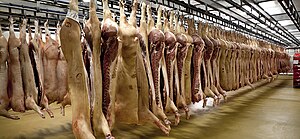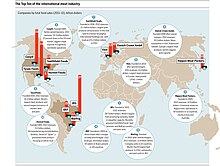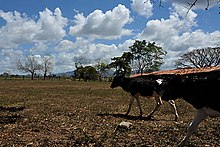
Meat is animal tissue, often muscle, that is eaten as food. Humans have hunted and farmed other animals for meat since prehistory. The Neolithic Revolution allowed the domestication of animals, including chickens, sheep, goats, pigs, horses, and cattle, starting around 11,000 years ago. Since then, selective breeding has enabled farmers to produce meat with the qualities desired by producers and consumers.
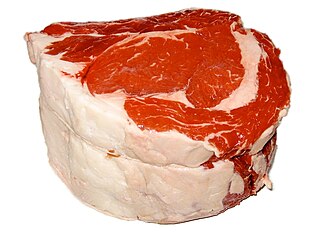
Beef is the culinary name for meat from cattle. Beef can be prepared in various ways; cuts are often used for steak, which can be cooked to varying degrees of doneness, while trimmings are often ground or minced, as found in most hamburgers. Beef contains protein, iron, and vitamin B12. Along with other kinds of red meat, high consumption is associated with an increased risk of colorectal cancer and coronary heart disease, especially when processed. Beef has a high environmental impact, being a primary driver of deforestation with the highest greenhouse gas emissions of any agricultural product.

In livestock agriculture and the meat industry, a slaughterhouse, also called an abattoir, is a facility where livestock animals are slaughtered to provide food. Slaughterhouses supply meat, which then becomes the responsibility of a meat-packing facility.

Animal husbandry is the branch of agriculture concerned with animals that are raised for meat, fibre, milk, or other products. It includes day-to-day care, management, production, nutrition, selective breeding, and the raising of livestock. Husbandry has a long history, starting with the Neolithic Revolution when animals were first domesticated, from around 13,000 BC onwards, predating farming of the first crops. By the time of early civilisations such as ancient Egypt, cattle, sheep, goats, and pigs were being raised on farms.

The meat-packing industry handles the slaughtering, processing, packaging, and distribution of meat from animals such as cattle, pigs, sheep and other livestock. Poultry is generally not included. This greater part of the entire meat industry is primarily focused on producing meat for human consumption, but it also yields a variety of by-products including hides, dried blood, protein meals such as meat & bone meal, and, through the process of rendering, fats.

Conversations regarding the ethics of eating meat are focused on whether or not it is moral to eat non-human animals. Ultimately, this is a debate that has been ongoing for millennia, and it remains one of the most prominent topics in food ethics. Individuals who promote meat consumption do so for a number of reasons, such as health, cultural traditions, religious beliefs, and scientific arguments that support the practice. Those who support meat consumption typically argue that making a meat-free diet mandatory would be wrong because it fails to consider the individual nutritional needs of humans at various stages of life, fails to account for biological differences between the sexes, ignores the reality of human evolution, ignores various cultural considerations, or because it would limit the adaptability of the human species.

Environmental vegetarianism is the practice of vegetarianism that is motivated by the desire to create a sustainable diet, which avoids the negative environmental impact of meat production. Livestock as a whole is estimated to be responsible for around 15% of global greenhouse gas emissions. As a result, significant reduction in meat consumption has been advocated by, among others, the Intergovernmental Panel on Climate Change in their 2019 special report and as part of the 2017 World Scientists' Warning to Humanity.
Animal welfare and rights in Israel is about the treatment of and laws concerning nonhuman animals in Israel. Israel's major animal welfare law is the Animal Protection Law, passed in 1994, which has been amended several times since. Several other laws also related to the treatment of animals: Rabies Ordinance, 1934; Fishing Ordinance, 1937; Public Health Ordinance, 1940; Wildlife Protection Law, 1955; Plants Protection Law, 1956; Criminal Procedure Law, 1982; Animal Disease Ordinance, 1985; National Parks, Nature Reserves, National Sites and Memorial Sites Law, 1991; the Law of Veterinarians, 1991; Dog Regulation Law, 2002; Rabies Regulations (Vaccinations), 2005; and Prohibition on declawing cats unless for reasons vital to the cat's health or owner's health, 2011.
Animal Outlook, formerly known as Compassion Over Killing (COK), is a nonprofit animal advocacy organization based in Washington, D.C. It is headed since May 2021 by Executive Director Cheryl Leahy, who succeeded Erica Meier. Formed in 1995, as a high school club, their primary campaigns are to advocate against factory farming and promote vegan eating. While the group welcomes those who are interested in animal welfare who eat meat, it encourages a transition to a plant-based diet.

An animal product is any material derived from the body of a non-human animal. Examples are fat, flesh, blood, milk, eggs, and lesser known products, such as isinglass and rennet.
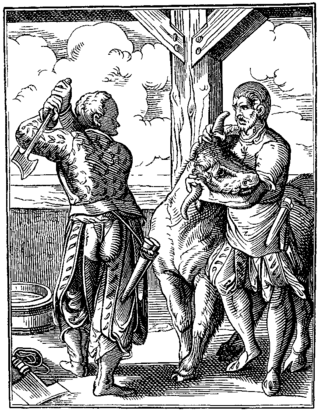
Animal slaughter is the killing of animals, usually referring to killing domestic livestock. It is estimated that each year, 80 billion land animals are slaughtered for food. Most animals are slaughtered for food; however, they may also be slaughtered for other reasons such as for harvesting of pelts, being diseased and unsuitable for consumption, or being surplus for maintaining a breeding stock. Slaughter typically involves some initial cutting, opening the major body cavities to remove the entrails and offal but usually leaving the carcass in one piece. Such dressing can be done by hunters in the field or in a slaughterhouse. Later, the carcass is usually butchered into smaller cuts.

Intensive animal farming, industrial livestock production, and macro-farms, also known as factory farming, is a type of intensive agriculture, specifically an approach to animal husbandry designed to maximize production while minimizing costs. To achieve this, agribusinesses keep livestock such as cattle, poultry, and fish at high stocking densities, at large scale, and using modern machinery, biotechnology, and global trade. The main products of this industry are meat, milk and eggs for human consumption. There are issues regarding whether intensive animal farming is sustainable in the social long-run given its costs in resources. Analysts also raise issues about its ethics.

A low-carbon diet is any diet that results in lower greenhouse gas emissions. Choosing a low carbon diet is one facet of developing sustainable diets which increase the long-term sustainability of humanity. Major tenets of a low-carbon diet include eating a plant-based diet, and in particular little or no beef and dairy. Low-carbon diets differ around the world in taste, style, and the frequency they are eaten. Asian countries like India and China feature vegetarian and vegan meals as staples in their diets. In contrast, Europe and North America rely on animal products for their Western diets.

Poultry farming is a part of the United States's agricultural economy.

Livestock are the domesticated animals raised in an agricultural setting in order to provide labour and produce diversified products for consumption such as meat, eggs, milk, fur, leather, and wool. The term is sometimes used to refer solely to animals who are raised for consumption, and sometimes used to refer solely to farmed ruminants, such as cattle, sheep, and goats. Horses are considered livestock in the United States. The USDA classifies pork, veal, beef, and lamb (mutton) as livestock, and all livestock as red meat. Poultry and fish are not included in the category. The latter is likely due to the fact that fish products are not governed by the USDA, but by the FDA.
Labor rights in the American meatpacking industry are largely regulated by the National Labor Relations Board (NLRB), which regulates union organization. The Occupational Safety and Health Administration regulates the safety and health conditions applicable to workers in the American meat packing industry. According to scholars of the American meat packing industry, despite federal regulation through OSHA and industry oversight, workers in meat production plants have little agency and inadequate protections. Workers in the industry perform difficult jobs in dangerous conditions, and are at significant risk for physical and psychological harm. In addition to high rates of injury, workers are at risk of losing their jobs when they are injured or for attempting to organize and bargain collectively. Several of studies of the industry have found immigrant workers—"an increasing percentage of the workforce in the industry."
Animal welfare and rights in India regards the treatment of and laws concerning non-human animals in India. It is distinct from animal conservation in India.

This article is about the treatment of and laws concerning non-human animals in Australia. Australia has moderate animal protections by international standards.
Farm Forward is a 501(c)(3) nonprofit whose mission is to promote conscientious eating, reduce farmed animal suffering, and advance sustainable agriculture. Farm Forward aims to eliminate the most harmful practices in intensive animal agriculture, increase the market share of humane and sustainable animal agriculture, and raise awareness about the cultural significance of animal agriculture.

Animal–industrial complex (AIC) is a concept used by activists and scholars to describe what they contend is the systematic and institutionalized exploitation of animals. It includes every economic activity involving animals, such as the food industry, animal testing, medicine, clothing, labor and transport, tourism and entertainment, selective breeding, and so forth. Proponents of the term claim that activities described by the term differ from individual acts of animal cruelty in that they constitute institutionalized animal exploitation.
